I’m back from the comic shop this week and I got four new comics.
Check them all out here:
I’m back from the comic shop this week and I got four new comics.
Check them all out here:
I’m moved tonight to write about my trips to the comic book store. Or stores as the case may be. It’s one of those everyday (or every week) things that slip away unnoticed with time. In the mid-1970s before the age of the comic shop I used to go to local stores that had newsstands to buy my comic books. At first it was the 7-11 behind my house. They had a spinner rack and they got new comics in every week. They’d put the new ones on the stand every Thursday afternoon and I’d be there to check them out and buy the ones I wanted.
As the 1970s wore on comics on the newsstand were starting to die. Newsstands didn’t want to bother with the low price and low profit comic books. They’d rather sell higher priced magazines. My local 7-11 started to not care so much about the comics and it showed. They got fewer of them in and put them out in an inconsistent manner. I also think they changed owners. About that time I was lucky to find another store called Stout Steve’s that was a bike ride away and took more care with their comics. That became my regular place for comics on Thursdays for a few years. I can remember putting the bag of comics under my shirt and then tucking my shirt into my pants to be able to ride my bike without having to hold the comics in my hand. Messenger bags were a long way off.
In the summer of 1981 I turned fifteen and a comic shop opened in a town about ten miles away. That was as cool as it gets. Of course being ten miles away meant that I couldn’t get there without a ride. So I visited it every so often but still continued my trips to Stout Steve’s every week. My friend Steve and I did bike ride the ten miles to the comic shop one summer day. That was the only time I made it there under my own power.
My friend Rob (who I met in high school) and I both turned 16 the next year. We both got our driver’s licenses but I don’t think it was until the next year (1983) when we were 17 that Rob got access to the family car on a regular basis. That’s when we started going to the comic shop on a regular basis. Saturday mornings he’d drive over to my house to pick me up and we’d travel the ten miles to Nyack NY and M&M Comics.
That is also when I found out about having a “Pull list.” If you wanted to buy a certain comic you’d tell the store ahead of time and they’d pull it for you and put it aside for when you came in. Comic books are usually published monthly or every two months so I could just put the X-Men on my pull list and it would be at the comic shop waiting for me every month. That way I wouldn’t miss an issue.
As time went on besides M&M Comics we started to add a couple of other stores to our itinerary. We would head over to the local mall and check out the record store and book store. After a couple of more years we added video game stores to that list.
In about 1984 a second comic shop opened in that mall. It was once a used bookstore called The Paperback Exchange that we would check out every now and then but we noticed it started to add comics. Then slowly the books disappeared and the comics took over. I still kept my pull list at M&M Comics but would buy a book or two at the Paperback Exchange.
In 1984 Rob and I both graduated form high school and went off to college. No longer could we make it to the comic shop weekly but we still had our pull lists there. Whenever we were both back home for the weekend we’d meet up and go to the comic shop and our other stores.
My first college was up at what is now SUNY Sullivan in the Catskills. It was a two year school and there were no comic shops anywhere around. My second school was SUNY Purchase in Westchester NY. Nearby was the White Plains Galleria and in that mall was a comic shop named “Hero’s World.” I made a bunch of new friends at Purchase and some of them were comic books fans so we made occasional trips to Hero’s World. It was always fun to get off campus and go get some comics. Not my pull list stuff but whatever caught my fancy.
About a year after I graduated from college I found myself working at Marvel Comics. Suddenly there were comics around me everywhere all of the time. I could pretty much get any Marvel or DC comic that I wanted for free. The funny thing was that by that time I wasn’t really reading any Marvel or DC comics. I was pretty much an indie comics guy.
My tastes had always run to the weirder less mainstream comics even when I was a kid buying comics off the newsstand. I especially like all the strange offbeat comics that Marvel published in the late 1970s. After M&M Comics opened in 1981 I was introduced to indie and small press comics. Stuff that couldn’t be found on the newsstands and only was distributed to comic shops. So even though I was surrounded by comics at Marvel I still would go to the comic shop.
Rob had moved back into town after he graduated college and so we resumed our trips to the comic shop. It wasn’t every week as I was often away on Saturdays, staying in the city with friends for the work week, or had a long commute that left no time after the work day but we usually made it every two to three weeks at the longest.
The the first half of the 1990s was a boom time for comic books. A couple of new comic book stores opened up in the county and though we weren’t regulars at them we’d check them them out every now and again. It was also a boom time for video games so there were two or three video game stores in the Nanuet Mall alone. That could really kill a Saturday morning. It was a different world in 1993.
In December of 1998 M&M Comics closed it’s doors for good. I had a pull list there for fifteen years. The Paperback Exchange was now called The Comics Warehouse and I moved my pull list over to there. Things went on that way for a while until some time in the early 2000s (I can’t even remember when) Rob moved out of town and over the border into New Jersey. That’s when we started to meet up at the comic shop rather than drive over together. Most of the bookstores, music stores, and video game stores on our mall run were closed by then so it wasn’t even a bother to cut them out. We had the internet for that.
In 2005 I stopped commuting into NYC. That meant I could get to the comic shop on a week night. New comic book day is on Wednesday but Rob and I usually don’t go until Thursday. That’s not set in stone or anything but it’s the general plan.
I’m not sure of the date but sometime around 2008 Comics Warehouse moved from it’s location near the Nanuet Mall into downtown Pearl River. So now, baring a text changing the plans, Rob and I meet at the comic shop in Pearl River at about 5 PM on Thursday nights. We hang out until it closes at about 6PM talking comics, movies, books, life, and whatever else comes up. John is the name of the guy who works that night and he always joins in. So do Roy and Dave if we go on a day when they’re working. Plus we chat with whatever regulars show up at the shop. It’s a grand old time. I was just there this evening.
I’m back from the comic shop this week and I got four new comics.
Check them all out here:
“People like cats.” That was my thought years ago when I first decided to draw some cat pictures. I’m guessing it was the early 2000s. I had never drawn many cats before, only one I can think of off the top of my head, nor many animals of any stripe but for some vague notion of popularity I decided to draw a few cats. I consider myself a dog person rather than a cat person but I somehow settled on cats to draw.
Of course the first thing I did was I went to the internet to look for some photos of cats. As most people know there are a lot of cat photos online. But finding one I could make a drawing from was hard. I’m very picky when it comes to any kind of photo reference. I prefer to shoot my own photo reference so I can get exactly what I want but that’s not always possible. So I end up looking through a thousand cat phots to find a few that were good for me.
It turns out that the facial structure of a cat suits my stripped down graphic drawing style. The eyes, the mouth, the nose, the ears, and the whiskers all can be broken down into simple and attractive shapes. Drawing a cat’s face that says “Cat’s face” is not too hard. At the right angle with the right shapes it all comes together. Dogs are much harder. They have much more variety in head shapes and sizes. Plus those long noses don’t translate as well into a simple drawing. A cat was the right drawing choice for me.
I can remember one of the problems I was having with the cat’s face was the center of its head. The forehead. It tended to be blank and flatten out the face. Any attempt at shading or delineation of fur just muddied the waters. So I ended up putting a symbol on the cat’s forehead. That’s how I got “Arrow Cat”, “Ankh Cat”, and “Infinity Cat.” Since I’m a fan of symbols I think that part worked out fine.
I made the 8×10 inch acrylic on canvas painting of Ankh Cat back when I first started drawing cats. I made him a purple cat. The purple is pretty strong but the red behind him is equally as strong. That gives this painting the feeling of a traffic sign. It seems the cat is trying to warn us about something but I’m not sure what. Emphasizing the rectangular shape of the canvas with the green outline and the blue rectangles makes this even more of a road sign. The dark blue brush strokes bring it back to a painting but I still can picture this as a sign on some remote European mountain.
You can see a few different shapes in the fur in this one. There is the basic black line that shapes the whole cat but since this was a painting I didn’t stick with just that. Painting offers the opportunity to use color and texture so that is what I did. We’ve got light pink strokes, magenta dots, and dark purple strokes all coming into play to make the cat’s fur. It’s a modernist painting approach where the paint isn’t literal but sees itself as paint on canvas. So at the same time we see the cat but know it’s made of paint.
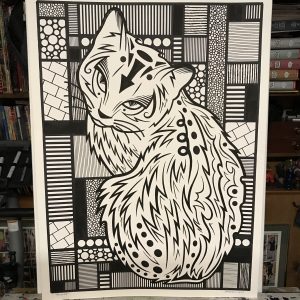
Now we’ll fast forward to just a week ago. I was looking through my drawings looking for something to make a big ink drawing out of and guess what though one through my head. “People like cats.” I scan my stuff as a matter of course so I have all my old drawings and painting scanned in and waiting for me. I did a search for my cat drawings and found good old Arrow Cat. The only thing missing was an idea for the background.
The background of the painting was all about painting and that wouldn’t work in a drawing. I contemplated some kind of landscape behind the cat but that didn’t go with the graphic design drawing that I had planned. I even tried out some drawings of faces and such but none of that worked. It only distracted me from the cat. I ended up putting in various Mondrian lines in the background (I was working on the computer) and that seemed to pull it together. I knew the boxes it formed wouldn’t stay blank but I knew I could figure them out later.
That’s when I blew up the drawing to full size and transferred it to a 22×30 inch piece of paper. The original drawing had about the same number of lines that you see in the painting. I knew I would need more lines in the fur but once again I would draw them as I went. So after I transferred the drawing I grabbed my brush and ink and started inking what was there.
It took a fair amount of time draw the cat in ink. I kept the lines sharp and precise so that meant slow and deliberate. After I finished the first pass there were about half of the amount of lines you see in the finished piece. Then I stepped back to see what other lines were needed. I’s grab the pencil, draw some in, decide if they were correct or not, and then ink them in if they were correct. The fur still wasn’t finished after the second pass but I decided to move onto the back ground.
I knew I would need a lot of different textures in the background and that would take some time. It’s amazing that after years of experience I can just see what texture I need next. I’d stare at the background for a few minutes and “Vertical Stripes in the left box” would just come to me. I could picture it in my head before I did it. They come in order too so I can’t picture it all at once but as I go along I can picture the next one.
As I worked on the background I also worked on some more of the fur. I’d switch between them. Four or five boxes of texture and then a few marks on the fur. Pretty soon I had the background finished but not the fur. That still had some small touches to go.
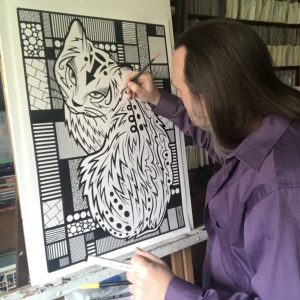
It takes time for a young artist to learn when something is finished but I haven’t been a young artist in a long time. I can tell when a piece is finished pretty easily. I can look at the cat and see that it’s almost done but not quite there yet. If I look at it closely something will suggest itself. Some line or mark. I look at it until I see there is nothing left to do. Its not even a question. It’s almost done, it’s almost done. It’s almost done, and then “Boom!” It’s done. Somewhere on there I put down one last line and the drawing was done. That’s a good feeling.
I’m back from the comic shop this week and I got six new comics.
Check them all out here:
I’ve been doing a lot of big ink drawings in the last two months. I think I’ve gotten nearly twenty of them done. I’ve also written about a few of them. But this week I thought I’d write not about the drawings themselves but about the tools I use to make my big ink drawings. Sometimes I mention a key tool or two that I use to make a given drawing but these big drawings are different then my smaller ones in that I use a lot of tools. These are the things that get lost to time so I like to document them.
An Easel and a drawing board – These two things are obvious but I thought I’d mention them. First I place the drawing board on the easel and then I tape the drawing to the board. I use an easel to keep the drawing vertical. The same reason everyone uses one.
White paper tape – A simple tool that keeps the paper attached to the drawing board. It’s an artist’s tape with low adhesion so it doesn’t wreck the paper when you pull it off. You have too keep an eye on it because that low adhesion also means the tape might not hold all the way through the making of the drawing. Sometimes the tape needs to be rubbed down again.

Windsor Newton Sable Series 7 or Raphael Master Brush Size #3 – The classic brush to use for inking comics. It’s a watercolor brush that comes to a sharp point and is great for just about any task when it comes to putting ink on paper.

Simply Simmons Round Brush Size #6 – This is a cheap synthetic hair brush that is twice the size of my Series 7 #3. So I use it for big lines and filling in blacks. It’s not as good or as versatile as a quality sable brush but they’ve come a long way with these synthetic brushes. I’d say synthetic brushes used to be about 50% of what a sable brush is but now it’s more like 80%. That’s a lot of improvement.

Busted Brushes – Old Series Seven brushes that no longer come to a point. I use these for my monster faces and such. They’re for when I want to paint with texture rather than line.

Sennelier India Ink – This is my favorite black India ink as of late. It’s thicker and darker than most inks and goes on dark. Its downside is that in can thicken up and not flow as well as it should. But with a little water it thins out again. Guessing the right amount of water can be a problem but not too much so. It’s also one of the more expensive inks but you get a lot of it if you buy the big bottle.
Blick Black Cat India Ink – This is the Dick Blick house brand of ink and as such it’s one of the cheaper ones. I bought a big bottle of it a few years ago and was disappointed with it. It was too thin and grey for me. A big bottle of ink has to be shaken up otherwise the pigment can settle on the bottom and the top will be thin. Even after vigorous shaking I couldn’t get this ink to be as dark as I wanted it to be. But I still used it. After a while I used enough of it so that there was some air in the top of the bottle. Somehow this thickened up the ink and it’s been a good thickness since. The last three quarters of the bottle have been excellent.
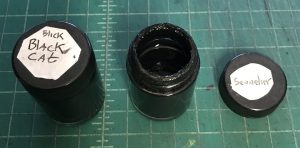
Copic Black Marker – A basic black marker with a chisel tip on one end and a fine point on the other. It can be refilled with marker ink which is good because it takes two to three markers to finish a drawing.
ShinHan Touch Black Marker – This is just like the Copic black marker except it comes from South Korea instead of Japan. I used up two bottles of ShinHan refills drawing these big drawing so I need to get some more.
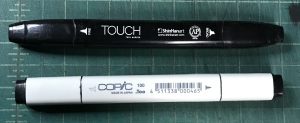
Flexible Ship’s Curve – Do you need to draw a long curve? This is what you need. It’s 24 inches long, can bend smoothly, and works well. Don’t bother with the “Flexible curve” that can be found in most art stores. That thing is worthless. Track one of these down instead.

Adjustable Curve – An Acu-Arc Adjustable Ruler. This is good for longer symmetrical curves. It bends slightly to change the arc of the curve. It’s about twelve inches long. Most French curves aren’t symmetrical so this fills in where those can’t be used.
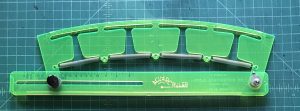
French Curves – I’ve got a lot of these. All different shapes and sizes. They’re generally pretty small compared to the ships curve or the adjustable curve but I do have two extra large French curves. I don’t use the bigger ones much. Usually one of the smaller ones will do the job.
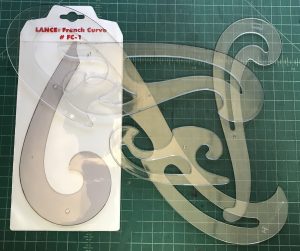
Haff Cross Hatching Machine – I’ve mentioned this before in blog posts. This is a handy little machine that helps me make all my parallel lines. I press a lever and then the ruler moves down a few millimeters and I draw a line. Repeat this for all the straight edge lines and I can draw perfectly spaces line patterns.
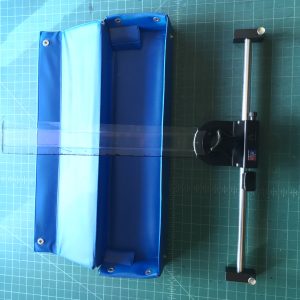
Ruler – Nothing complicated here. I need to measure an inch all around my paper so I can draw a border. I use a architect’s scale that I’ve had since my freshmen year of college. It measures in inches but I have another that’s just a couple of years younger that measures in the metric system. I’ve had these two for a long time.
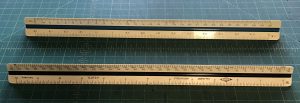
A long straight edge – I’ve got a long straight piece of wood that I use for making the borders around my drawing. It’s about an inch square and thirty two inches long. It was just a piece of scrap wood that I had lying around and one day I grabbed it to use as a straight edge. I’ve been using it ever since.
![]()
Triangle – For these big drawings I use my clear 30º/60º triangle for straight edges. It has a grid built into it that I can line up with the edge of the paper if I need to square up lines. And I always need to square up lines.
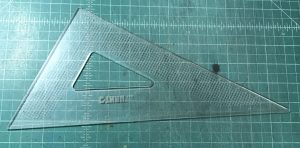
Circle and Elipse Templates – More basic stuff. If you want to make perfect circles and eclipses then these are what you need.
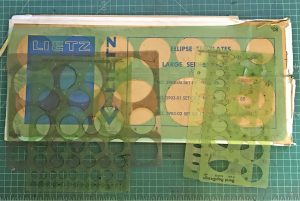
So there you go. That’s everything I use to make these drawings. No you can go make some of your own.
I’m back from the comic shop this week and I got three new comics.
Check them all out here:
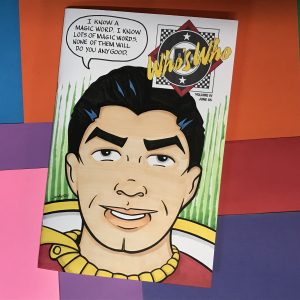
I just spent way too much time drawing a couple of sketch covers. These were two hand bound sketch covers. That means instead of buying two new comics that have a blank cover made for drawing on I instead picked out two old comics from my collection, pulled the staples, wrapped drawing paper around them, and put the staples back in. I used two old “Who’s Who?” comics from DC.
Sometimes I do sketch covers just as I would any other piece of art for art’s sake and sometimes I do them to try and sell them on eBay or Etsy. That’s an important distinction because If I’m making them for sale I have to watch how much time I spend on them. Sketch covers don’t sell for very much money. Most I see sold go for between $25 and $50. So I can’t spend half a day trying to make $25. It’s kind of moot because no one ever buys my sketch covers but I did just spend half a day trying to earn $25. That really makes for a failure of a day.
I love drawing faces. They’re one of my favorite things to draw and I draw them all the time. But when I draw faces I’m always looking for something new in a face. Some shape, form, or composition that is new to me. A little bit different. Faces give you a lot of leeway to steer away from reality and still have everybody know what you’re drawing. The problem I have with drawing comic book characters is that their faces are set in stone. If they’re not drawn a certain way then there is no point in drawing them.
When drawing an established character the number one thing you have to do is make that character easily recognizable. If you make a drawing of Spider-Man and nobody knows that it’s Spider-Man then you’ve failed. You’ve made the drawing pointless. You may as well have drawn any old face. Since I was doing a couple of DC Comics sketch covers I picked a character from each comic to draw on the cover. Cyborg and Shazam (the original Captain Marvel).
I’m pretty good at simplifying things. It’s one of my drawing strengths. I’ve made plenty of baseball card size drawings of super hero faces and they’ve come out pretty well. It does take me a bit of time to figure out exactly how to draw them but not an excessive amount of time.
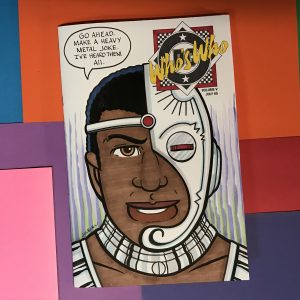
The problem is that I wanted to draw these sketch cover heads as if they were my sketch card heads except the size was much bigger. 6.5×10 inches as opposed to 2.5×3.5 inches. That’s a different type of drawing. Things change in a drawing when the scale changes. A solution to a drawing problem at one inch isn’t the same solution at one foot. That’s the nature of drawing and scale. A nature I struggle with on occasion.
I just got a new 5.5×8.5 inch spiral bound sketchbook. I decided that would be a good place to do some drawing of superhero faces. I like to give each of my sketchbooks a purpose and that would be a good purpose for this one. I could make the drawings, scan them into the computer, size them, and then transfer them to the sketch cover. So that’s exactly what I did. But boy did it take time.
For some reason when drawing a fixed character head at that size symmetry is always a problem for me. The left and right sides don’t always match. Human faces are rarely symmetrical in real life but often in my drawings they are even more off. I have to really pay attention and use tracing paper to mirror my sides of the face in order to get things right. When drawing a head that is not a defined character I’m often looking to make things little asymmetrical so now doing the opposite takes time. Even with the character Cyborg, who has an asymmetrical head, I had to work hard to get the symmetry correct. One eye kept floating up and I had to bring it down.
Shazam’s head was a tough one too. He’s a character from the Golden Age of Comics and the artists who draw him back then were really good at simplifying. Of course they weren’t drawing his face six inches tall. I had to take his simplicity and try to make it work at a size it wasn’t meant for.
One of the things about comic book drawing is that as a drawing gets bigger more detail is supposed to be added. Superman’s face at an inch tall doesn’t look the same as Superman’s face at three inches tall. That’s just the way things are done. In an animated cartoon a character’s face is the same no matter what size it’s drawn at but not in a comic book. So I was not only drawing Shazam’s face but I was drawing it at a size it wasn’t meant for. That took more time than I anticipated.
After I had the drawings finished and transferred them to the sketch cover paper it was time to ink and color them. This had me baffled. I wasn’t sure how I wanted to ink them. The Cyborg face ended up being pretty complex with circle template and French curve work to be done. The Shazam head was simpler but also puzzling.
Usually I ink with a brush. That’s my default tool and what I’m best with. But I was baffled by the Cyborg face so I decided to go ahead and start my inking with a marker. I used a single line weight and inked over my pencil line. I put off 90% of the inking decisions. Then I stopped Cyborg and started inking Shazam. I used my brush for the Shazam face. It worked well for that and I was fine with how it came out. I was much happier than with the Cyborg face so then I went back to Cyborg with the brush and finished inking that one too.
After the inking I decided to keep it simple with the coloring. I used my markers as I always do with these sketch covers but I kept the molding to a minimum. I stuck with bright and flat color for the finish. It was a long journey to the finish but I got there.
I’m back from the comic shop this week and I got six new comics.
Check them all out here:
When I make art I generally like to keep things simple. Over the years I’ve learned to be pretty good at simple but it’s not easy. Simple is usually hard. Simple is stripping things down to the basics. If a form can be defined with just one line than use that one line. The problem is finding that one line (that’s the story of art). It can’t be wrong in any way. After all there is only one of them. If I’m going to draw a form with all sorts of shading and hatching then I might use hundreds of lines. If some of them are off you can’t even notice. That’s the advantage of plenty. One or two mistakes are easily hidden in a haystack.
Another of my art philosophies is that complexity is simplicity multiplied. By this I mean both are achieved in the same way. With complexity there is more room for error but you’re still putting one line on the paper at a time and you want to make that line nice. So to draw one face on a page can be simple but start to add more simple faces and things get complex.
You can strip down one face into the basics but as soon as you put another face next to it the two faces start to relate to each other in new ways. That has to be take into account. For example if two faces are next to each other you generally don’t want them to be identical. So you need two sets of solutions for how to draw a simple set of eyes. And a third and a fourth face and you need more simple solutions. That can get complicated.
I bring up this topic because I just finished a complicated big ink drawing (20×28 inches). As a matter of fact I just finished two complicated big ink drawings in a row. I wanted that second one to be simple but missed the mark by a mile. The first one I knew was going to be complicated. That’s how I planned it. I picked a complicated sketch, made a complicated drawing from it, and then made a complicated big ink drawing from that. It was what I was in the mood for but it took a lot out of me. Complicated can be physically demanding because there are so many lines to draw. So after that one I decided to get simple.
Complicated my be physically demanding but simple is more observationally demanding. You really have to look at things and puzzle them out. Often the preliminary drawing of a simple subject takes more time than a complex one. With simple everything has to be figured out in advance but with complicated you can leave some stuff for later. I know I’m going to need half a dozen textures in certain areas but there is no need to lock them all down early. With simple I have to lock things down early. I don’t want any surprises at full size.
Simple can get away from me sometimes. That’s what happened with the second complex drawing. I had decided that I wanted to draw a giant face and that’s usually simple but I overlooked things in this case. I overlooked a lot of things. I picked a sketch to work on that had a giant face in it but the face was really a monster mask. Plus there were another half a dozen faces in the drawing. I tried to keep all the faces simple but I was somehow in denial about how complex a drawing I actually picked.
As I blew up the drawing and transferred it to the large paper I began to see how much work there was to it. I started to draw it in ink with a simple line. I often start these big drawings with the simplest lines first and then get complex with them. By simple line I mean with a marker and a straight edge or French curve. These are simple lines that I later go into with a brush and ink. The marker part is usually pretty easy. I follow the pencil lines. There isn’t a lot to think about because these aren’t the finished lines. But as I put more and more of those lines in I began to notice how many decisions I would have to make later on down the line. This drawing was a lot more complicated than I initially thought it was.
To begin with the space in the drawing is bizarre. It isn’t a face with a background behind it. The top of the drawing had some clouds and the bottom some mountains as it if was a normal background but everything else was filled with faces and shapes like a modernist painting. That and the main face was a positive shape but it had another face in its neck that created a negative space within the positive space. It was strange, complex, and would not work properly until I figured it out. The problem was that figuring out the space meant figuring out about nine other things first.
I did it all a little bit at a time. I put down all my simple lines and then concentrated on one area. The eye in the bottom right corner, the clouds on top, the face under the chin, or anything else. I approached it one piece at a time. The hardest part was that I knew nothing was going to be finished until all of it was near completion. I would add textures and shapes to one area, then a second, then a third, and then I had to go back to revisit the first area. No place would be finished until it was all finished. That can be a frustrating way to work and takes a lot of trust in the process.
In the end this turned out to be one of my most complicated big ink drawings. I count seven small faces, one big face, a faceless figure, and a lone eye. Plus there are about seven different background textures. I like the way it came out but I don’t know how in the world I ever thought this would be a simple drawing. I can really fool myself some days.